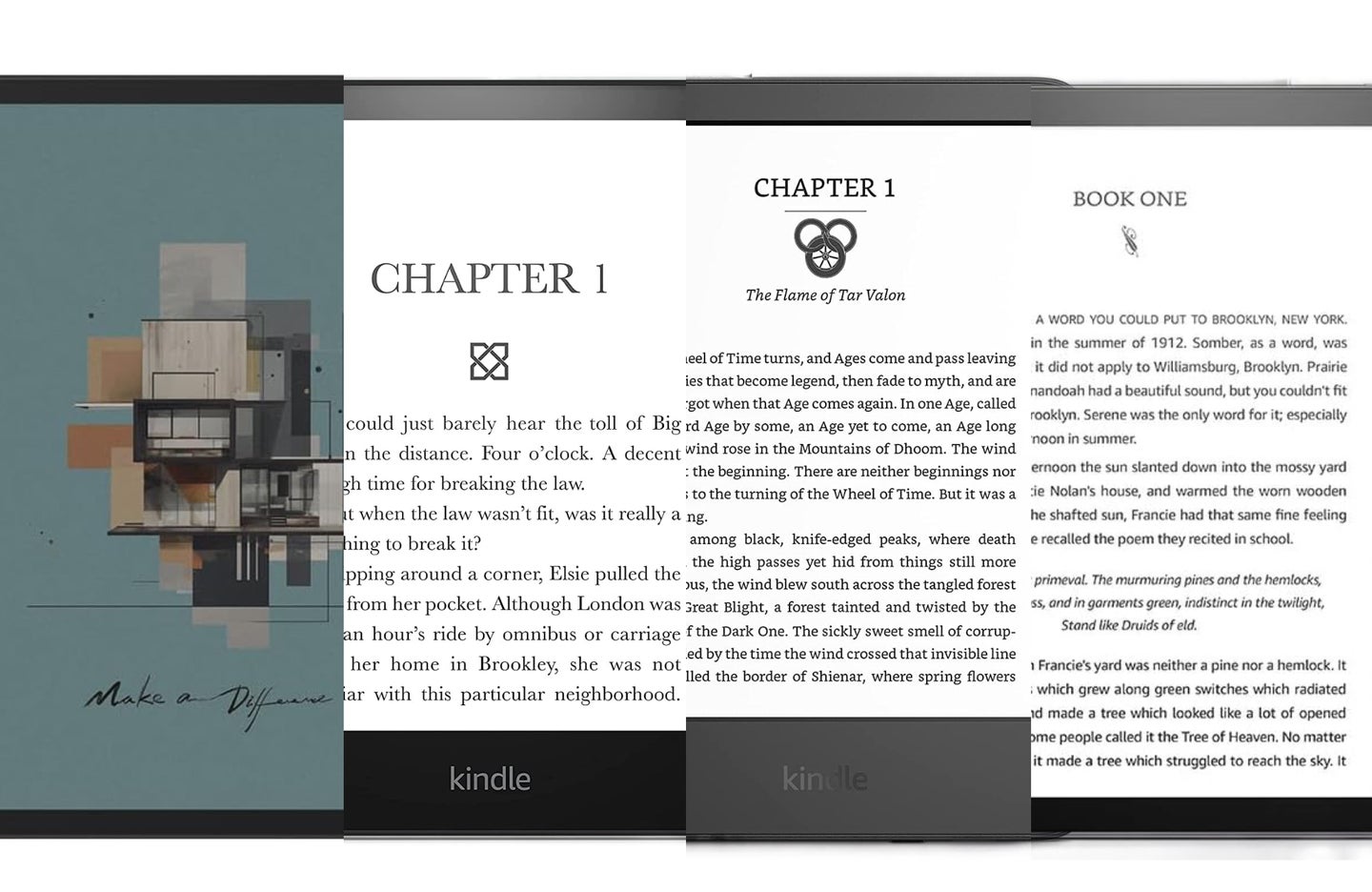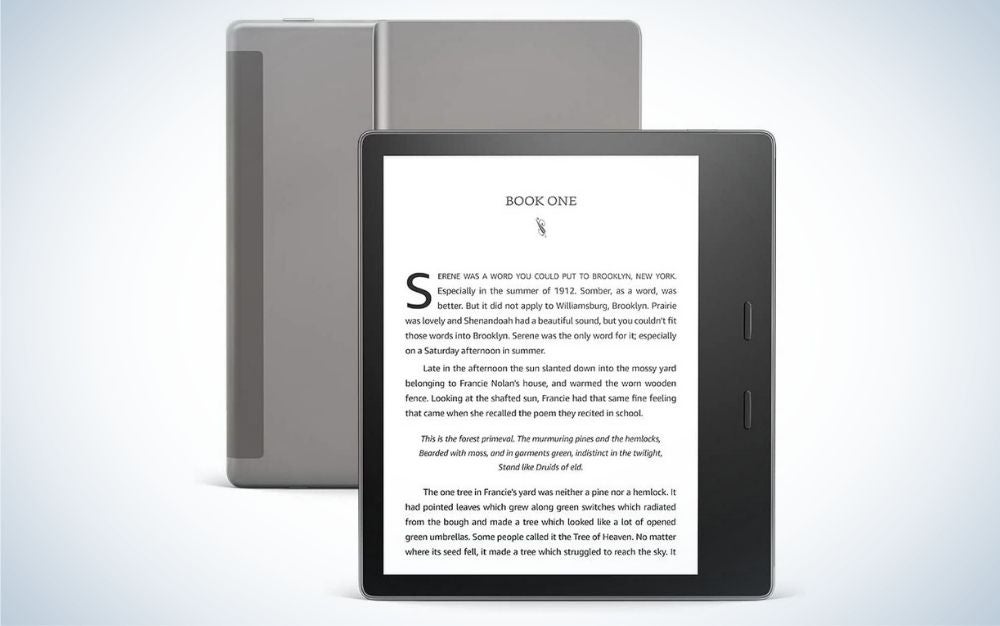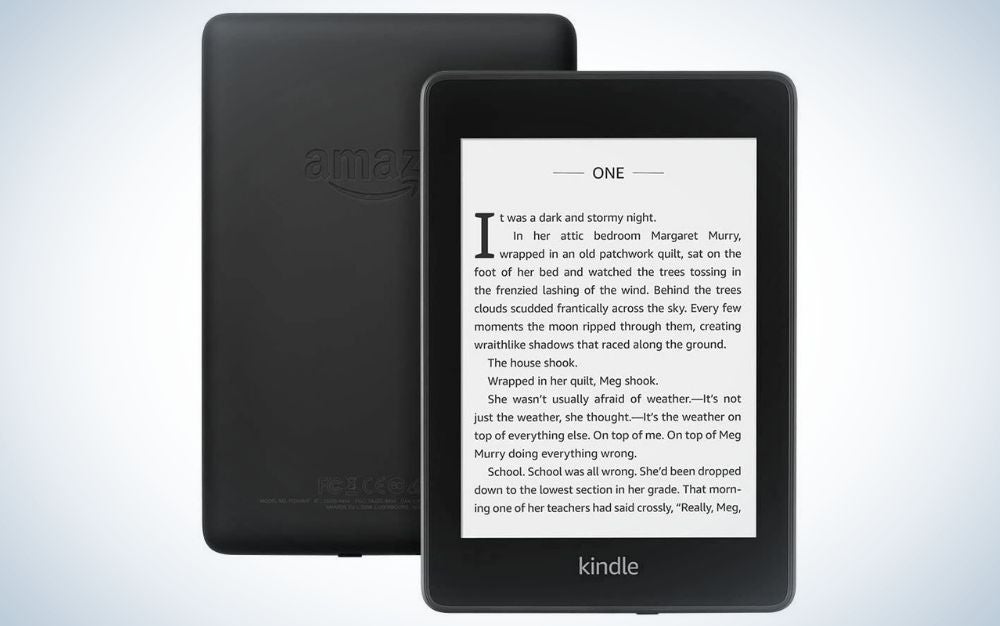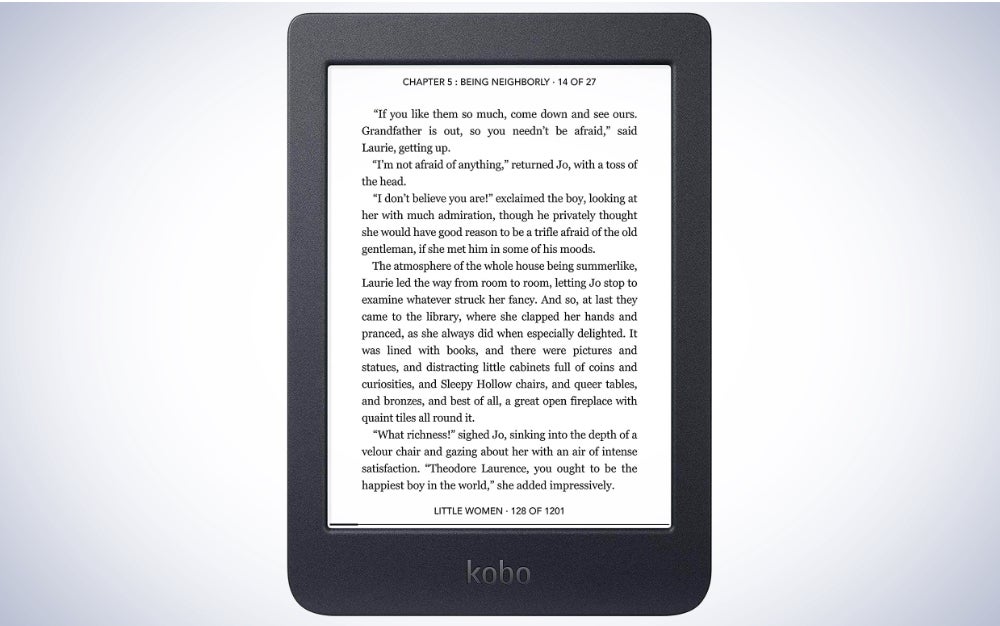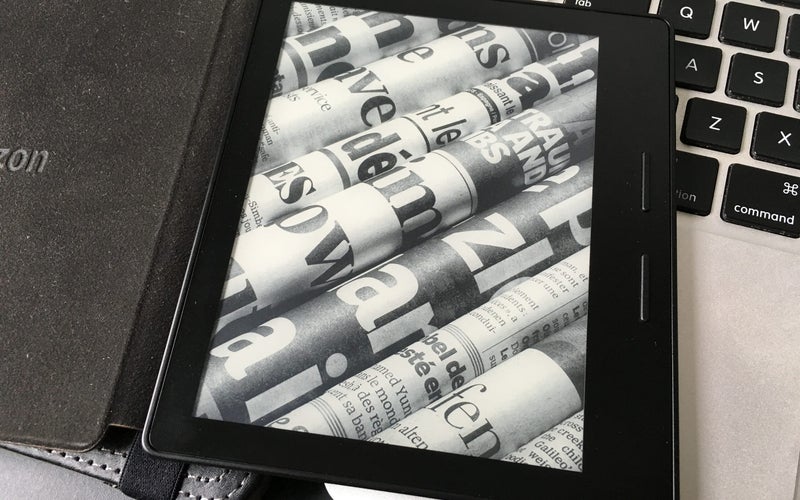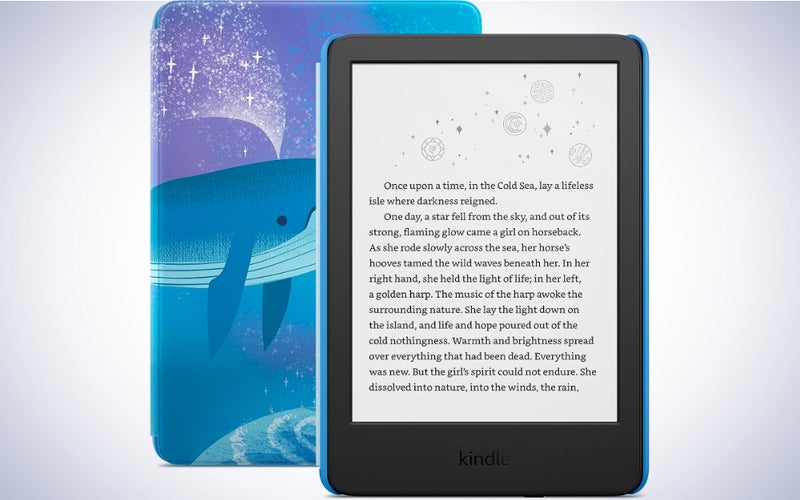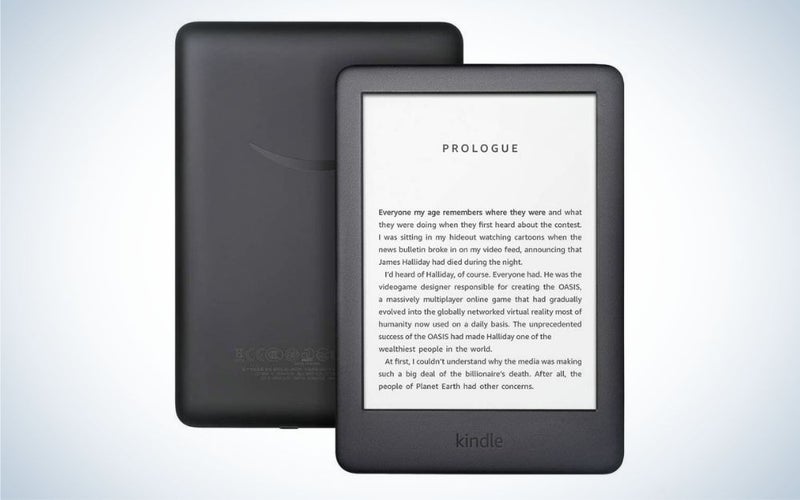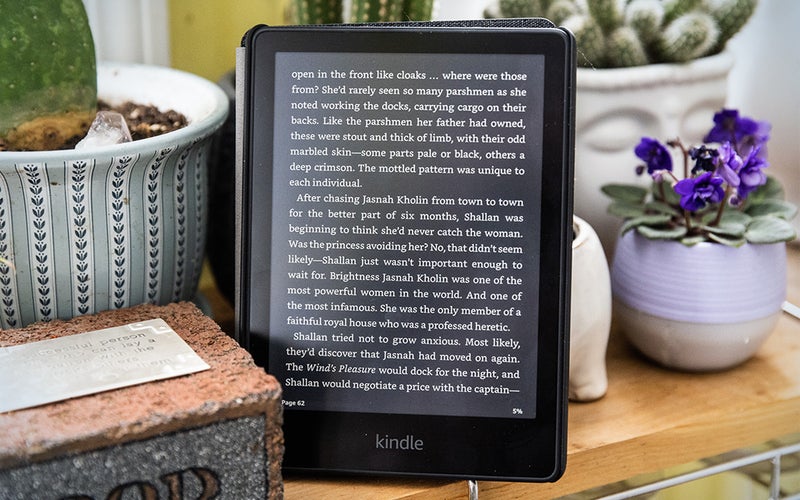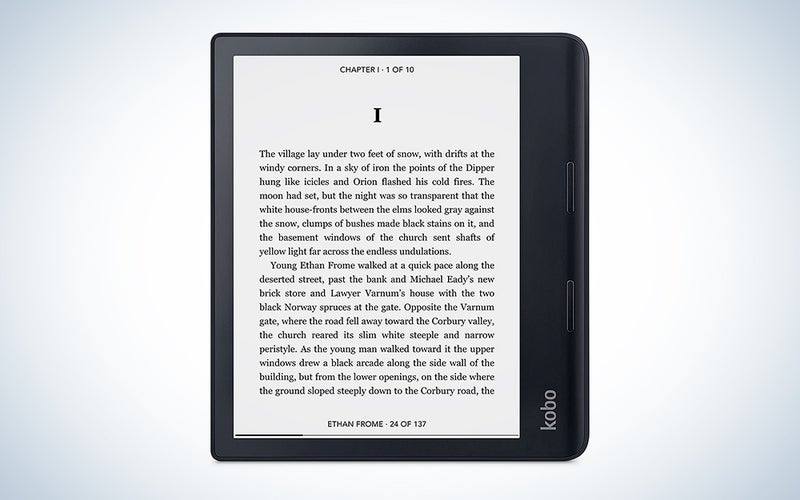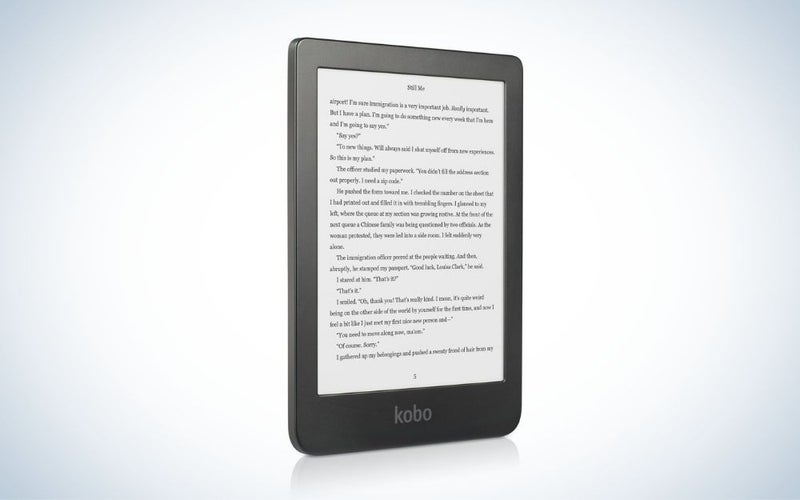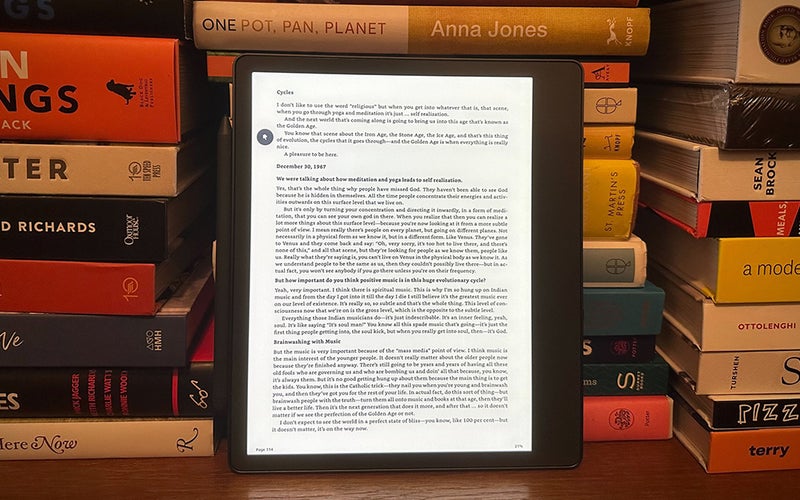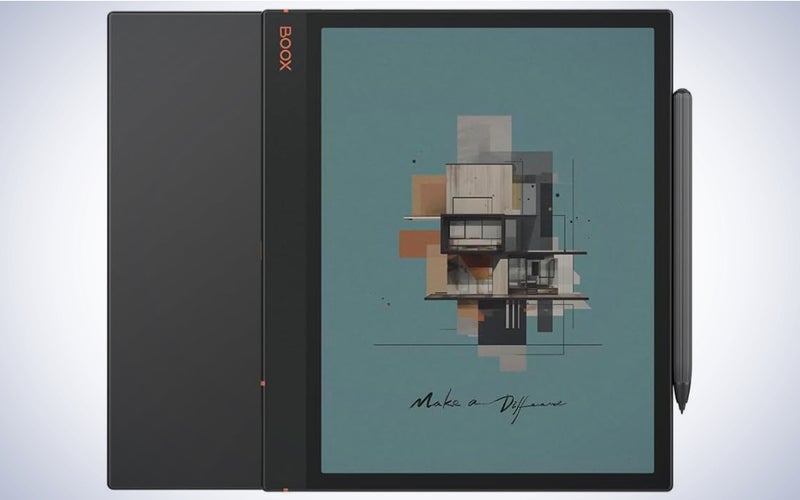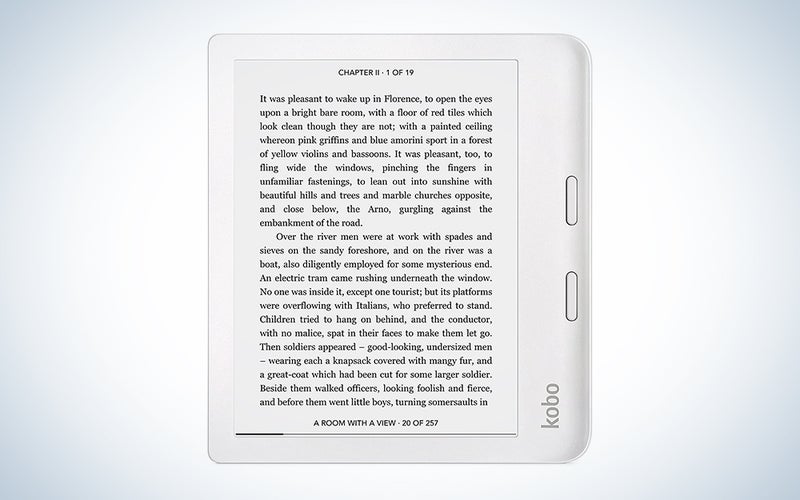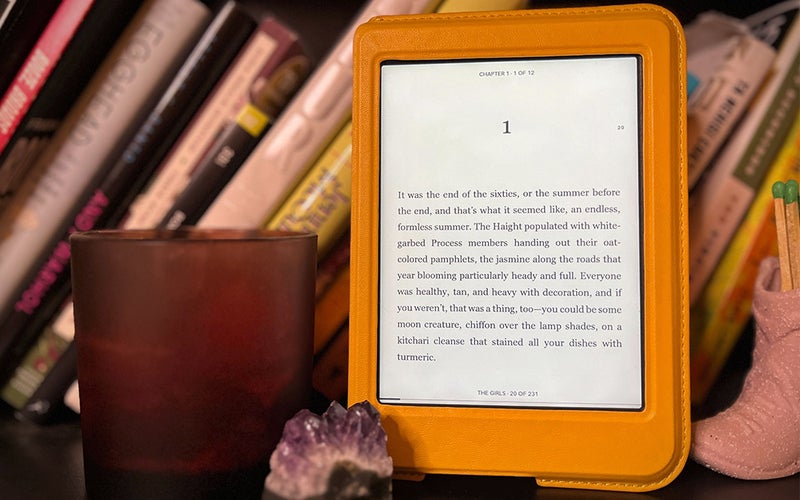We may earn revenue from the products available on this page and participate in affiliate programs. Learn more ›
An eReader is more than a convenient way to carry an entire collection of James Paterson novels onto an airplane. Today’s eReader screens are stunning, with sharp text that looks just like real ink and paper. These displays separate eReaders from tablets, making them the best way to read digital books. Modern eReaders are friendly and inviting. They encourage reading and provide services and apps you won’t find on traditional smartphones and tablets. With the best eReaders, you’ll access books, audiobooks, magazines, and more in a format dedicated to useability and your eyes.
- Best overall: Kindle Oasis
- Best for kids: Kindle Kids
- Best for seniors: Amazon Kindle
- Best for PDFs: Kindle Paperwhite
- Best for manga: Kobo Sage
- Best for library books: Kobo Clara 2E
- Best for students: Kindle Scribe
- Best color eReader: BOOX Note Air 3 C
- Best Kobo eReader: Kobo Libra 2
- Best budget: Kobo Nia
How we chose the best eReaders
The writers and editors working on this article have spent thousands of hours reading on paper books and electronic devices. We’ve felt the sting of tired eyes and are glad to leave the world of papercuts behind.
Taking a critical look at eReaders starts with display clarity. These devices are designed for easy reading, and the best of the bunch must have an impressive, crisp look as close to analog ink and paper text as possible.
Most eReaders on the market offer similar stats for battery life and storage space, so we focused on the factors that separate the readers—namely screen lights, screen size, and file options. An eReader must be as easy to see as it is to navigate, and generic budget-priced eReaders are notoriously clunky with interfaces that look more like a calculator screen than a soothing, inviting digital library. We ran through the eReader menus, checking for speed and intuitiveness. If we hit a roadblock and had to click the “help” function to figure out what to do, it was a big red flag for casual readers.
Lastly, we considered price. Devices over $250 must have something special to offer (like a color display), or why spend the money? And devices less than $70 seem sketchy from the start and will likely crash regularly.
The best eReaders: Reviews & Recommendations
Today’s eReaders are sophisticated tablets capable of displaying text and images in a wide variety of eye-friendly ways. But with so many eReaders on the market, finding the device that suits your needs and reading habits can be difficult. Do you want an eReader with a clean, simple interface? Do you want an eReader with a lot of file options? Do you want an eReader for teens or younger children? One of the choices below should check all your boxes so you can spend more time ereading and less time searching the internet for the best eReaders.
Best overall: Kindle Oasis
Xavier Harding
Why it made the cut: Amazon’s newest Kindle Oasis eReader is the best eReader overall because it adds even more lighting options for a variety of color temperatures and displays crisp text on a big screen ideal for tired and weary eyes.
Specs
- Screen size: 7-inch screen
- Waterproof: Yes
- Resolution: 300 ppi
- Front light: 25 LED lights
- Storage: 8 or 32 GB
Pros
- Big, beautiful screen
- More LED lights than any other eReader
- Controls feel great
Cons
- No speaker or headphone jack (Bluetooth headphones only)
- Price is steep
- Not a huge upgrade from the previous Oasis eReader
The latest Kindle Oasis might be the best eReader overall. The screen is bigger than the standard 6-inch display of most Readers, with a resolution of 300 ppi (pixels per inch)—the sweet spot for crisp text. And the new LED lights can be automatically adjusted to suit your eyes and environment. The result is a stunning display that looks just as good in a dark room as on a sunny beach.
The Oasis is not cheap, costing twice as much as a Kindle Paperwhite. The bigger, brighter screen is worth the money if you spend a lot of looking at screens, and the physical controls make it the best Kindle if you prefer a more tactile experience. Page-turning is instant; even switching from book to menu screen is done with surprising speed and smoothness. Highlighting passages is also fast and simple.
Audiobook fans will need to provide their own Bluetooth speakers or true wireless earbuds, as there is no speaker or headphone jack on the device. But if you want a device to listen to audiobooks, your smartphone is probably better equipped for the job. At just under $250 for the 8 GB version, this luxury Kindle is for serious readers who want the best design for a professional, high-quality text-based experience.
Best for kids: Kindle Kids
Amazon
Why it made the cut: The Amazon Fire 7 Kids tablet has a colorful rubber case and reinforced body that makes this an easy pick as the best eReader for kids.
Specs
- Screen size: 6-inch screen
- Waterproof: No
- Resolution: 300 ppi
- Front light: Yes; 4 LED
- Storage: 16GB
Pros
- Long-lasting battery
- Amazon Kids+ subscription
- Two-year warranty
Cons
- Expensive for a kid-themed gadget
Finding an eReader that’s kid-proof can be tough, but Amazon has made it easier by introducing the Kindle Kids, a more child-friendly version of its entry-level eReader. On a technical level, the Kindle and Kindle Kids are identical. Both have a six-inch 300ppi e-ink display, four LED backlights, and a battery that can last for weeks at a time without needing to be plugged in.
The difference is that Amazon offers the Kindle Kids with a case, a two-year warranty, and one year of access to its Kids+ subscription service. Kids+ functions similarly to Amazon Kindle Unlimited: Children get unlimited access to a library of age-appropriate titles, which they can download and read at their leisure. Major titles that are available via Kids+ are the entire Chronicles of Narnia, Diary of a Wimpy Kid and Harry Potter series. This service costs $4.99 per month, so getting a free year cuts the Kindle Kids’ up-front cost in half.
The Kindle Kids also has friendly features like Word Wise, which shows synonyms and definitions above difficult words, and Vocabulary Builder, which allows kids to highlight words they don’t know and create flashcards from them. These features allow children to build their reading skills independently rather than asking an adult. The Kindle Kids is pretty pricey as far as kids tech goes, but it’s less expensive (not to mention distracting) than most tablets.
Best for seniors: Amazon Kindle
Amazon
Why it made the cut: The iconic Amazon Kindle is still one of the best eReaders for any age, but seniors will especially love the reading light, the user-friendly text options, and the low price.
Specs
- Screen size: 6-inch screen
- Waterproof: No
- Resolution: 300 ppi
- Front light: 4 LEDs
- Storage: 16 GB
Pros
- 4-week battery life when used for 30 minutes a day
- Affordable
- Simple design with no screen clutter
- Robust text size, spacing, and style options
Cons
- Front lights not as bright or bigger than others on this list
- No video features
The Amazon Kindle has come a long way since the first generation of eReaders. The most recent model added front lights for easy reading in the dark. The e-ink screen looks great even in sunlight, and the fonts can be adjusted to suit the reader’s needs, making it the best eReader for seniors.
Seniors will love the simplicity of the basic Kindle. The menu screens are barebones, and browsing the library is straightforward. Buying books is also a breeze, but make sure the readers understand how it works before they unknowingly rack up thousands of dollars in John Grisham debt.
The Amazon Kindle can also be used as an audiobook player, and a subscription to Audible makes listening to books cost-effective. But there is no internal speaker, so you need some noise-canceling Bluetooth earbuds (or a wireless speaker if you’re in a quiet place). We wish the screen were a bit bigger, as some seniors will still have trouble seeing the 6-inch display even when the size of the text is blown up. The next biggest Kindle size would be the Oasis, an upscale device that costs more than double the price of the standard Kindle. Save your money and stick with the affordable option.
Best for PDFs: Kindle Paperwhite
Stan Horaczek
Why it made the cut: The Amazon Paperwhite is not only thin, it has enough storage to load up thousands of PDFs, and the little eReader has no problem displaying PDFs on its gorgeous e-ink screen.
Specs
- Screen size: 6.8-inch screen
- Waterproof: Yes
- Resolution: 300 ppi
- Front light: 17 LEDs
- Storage: 8 or 16 GB
Pros
- Easy to add and read PDFs without lag
- Lightweight and thin enough for pockets
- Screen looks good even in sunlight
Cons
- Can’t read every file format, such as EPUB
- Easy to lose
- Must connect to a computer for file transfer
The Kindle Paperwhite represents a sweet spot for readers with a bit more cash to spend on an Amazon eReader for a few noticeable creature comforts. The 6.8-inch, 300 ppi screen may not seem like a huge improvement over the base model’s 6-inch display, but that extra fraction of an inch actually translates into more words on screen and fewer page turns during each reading session. That translates into thousands or even millions fewer turns over the device’s lifespan. The screen is still exceptionally sharp and clear—there’s just more of it (as I go into in my full detailed review).
The Paperwhite relies on 17 LEDs for its illumination, compared to just four in the standard Kindle. You can also adjust the color temperature of the Paperwhites LEDs to give either warm or cool tones.
For readers who want to consume their literature (or pulp) in the bath or at the beach, the Paperwhite’s IPX8 rating allows it to survive full submersion in fresh water (up to an hour) or seawater (up to three minutes). The standard Kindle doesn’t offer any real weatherproofing.
The Paperwhite generally offers a fairly great reading experience. The pages turn quickly, the navigation has been streamlined from previous versions, and it finally offers USB-C charging. Hence, you’re one step closer to finally recycling all those old MicroUSB cables.
I personally opted for the ad-supported version, which shows advertisements on the lock screen in exchange for a $20 discount on the device itself. That may not be worth it for you if your brain hasn’t become as hopelessly desensitized to ads as mine has.
Best for manga: Kobo Sage
Kobo
Why it made the cut: The Kobo Sage can handle just about every file format you want, a huge plus for Manga readers whose taste goes beyond Amazon’s limited offerings. And the big display makes art and text look great.
Specs
- Screen size: 8-inch screen
- Waterproof: Yes
- Resolution: 300 ppi
- Front light: Yes; LEDs unknown
- Storage: 32 GB
Pros
- Big 8-inch screen
- Looks good in wide landscape mode
- Supports multiple file formats
- Nice, tactile buttons for easy page-turning
Cons
- Buttons can feel a little slow
- Black and white only
- Expensive
Japanese graphic novels (manga) come in every genre imaginable from a wide variety of sources, so you’ll want an eReader that can handle every type of file format to read it all. The Kobo Sage’s large e-ink screen makes black-and-white manga look great, almost as good as physical paper. And holding the Kobo Sage sideways in landscape mode adds to the feeling of reading a real graphic novel.
The Kobo Sage is the best eReader for manga because it can read comic book files CBZ and CBR, plus ebook files EPUB, EPUB3, MOBI, FilePub, and PDFs. Navigating through a comic is easy, thanks to the side buttons. And the front lights allow for nighttime reading. It’s also waterproof for those who love to read at the beach or pool.
The biggest drawbacks are the price and the lack of color. For reading colorful American comics, you’ll be better off with a standard tablet like an iPad. However, this eReader does look better in sunlight than the glossy screen of an iPad. And manga fans will love the Koba Sage, even with the limitations.
Best for library books: Kobo Clara 2E
Kobo
Why it made the cut: For accessing and reading library books, the Kobo Clara 2E has a seamless interface with the library app Overdrive. If you love the library, this ebook reader gives you access to near-limitless free books.
Specs
- Screen size: 6-inch screen
- Waterproof: Yes
- Resolution: 300 ppi
- Front light: Yes; LEDs unknown
- Storage: 16 GB
Pros
- Comes ready for Overdrive library app
- Great screen looks like a real book
- A lot of text and display options
Cons
- Title offerings may be limited based on what your local library has available
- No cloud storage or syncing to other devices
OverDrive and its Libby app make it easier than ever to borrow books from your local library, and the Kobo Clara 2E eReader is the best eReader for library books. Sure, the Kindle can also link up to OverDrive and Libby, but if the library has a book incompatible with the Kindle, you’re out of luck. Kobo eReaders are better suited for displaying a variety of file formats.
Simply search for your library in the app or the online OverDrive website, plug in your library card info, and you’ll be set. The Kobo Clara 2E is ready to borrow books from your library of choice … assuming your library participates in the OverDrive program. (Most libraries do, and more are added every month.)
Besides the library functionality, the Kobo Clara 2E is a big improvement over older Kobo products. The display is crisper, and the touchscreen is responsive. Kobo may lack the streamlined UX design of the sleek and simple Kindle, but you’re getting more options and greater freedom to buy, borrow, and read the books of your choice.
Best for students: Kindle Scribe
Brandt Ranj
Why it made the cut: An easy-to-use interface and note-taking abilities mean you can use this eReader in and out of class.
Specs
- Screen size: 10.2-inch screen
- Waterproof: No
- Resolution: 300 ppi
- Front light: 35 LEDs
- Storage: 16, 32, or 64 GB
Pros
- Big, beautiful display
- High refresh rate
- Easy-to-use interface
Cons
- Expensive
- Only available with a stylus
The Scribe is Amazon’s first big-screen Kindle in over a decade, and this return to form should be welcomed by digital readers everywhere. The Scribe’s 10.2-inch display has the same 300 ppi screen density as its smaller siblings, making text look as crisp as ever. The screen also refreshes at the same rate, which means you can turn pages quickly without seeing long-lasting artifacts from the previous one on your screen.
Similarly, the Scribe has the same intuitive, gesture-based user interface as other Kindles, so you’ll be right at home if you’re familiar with any of Amazon’s eReaders. If you already have a collection of Kindle books, they’ll be available on the Scribe from the moment you first activate it, which is very helpful.
If all you want is a big-screen Kindle, you’re in luck: The Scribe gets full marks in this regard. Unfortunately, Amazon designed this eReader with a secondary purpose: note-taking. The Kindle Scribe is bundled with a basic or premium stylus, depending on how much you pay. Tapping the screen with your stylus allows you to create digital, handwritten notes, which you can refer back to later. You can annotate e-books and PDFs synced to your Kindle Scribe or create original notes on a blank canvas that can be accessed through the cloud.
Annotation on the Kindle Scribe works well enough, but it feels like this feature should be optional rather than mandatory. A Kindle Scribe with 16GB of storage and the Basic Pen runs costs $340. That’s tough to swallow if you don’t see yourself using the Scribe to write very often, if at all. A $300 basic Scribe with no pen would be easier to recommend. Still, if you have a library of Kindle books and want a large-screen eReader, you can’t go wrong with this one.
Best color eReader: BOOX Note Air 3 C
BOOX
Why it made the cut: While color e-ink technology is still in its infancy, the BOOX Note Air 3 C eReader is leading the pack with a good color display and responsive touchscreen, making it the best of this limited marketplace.
Specs
- Screen size: 10.3-inch screen
- Waterproof: No
- Resolution: 150 ppi
- Front light: Yes; LEDs unknown
- Storage: 64 GB
Pros
- Paper-like texture
- Handles all standard file types
- Stylus is good for taking notes
Cons
- Costs as much as an iPad but does less
Color e-ink displays are still a niche technology, but the BOOX Note Air 3 C is the best option yet, thanks to BOOX’s continued investment in improving its displays. Besides its display, the big differentiator with this eReader is that it runs Android, a much more capable operating system than the one found on Kindles and Kobos. You can download apps to read books from different digital libraries and even browse the web. The tradeoff is that e-ink displays don’t refresh information nearly as quickly as an LCD screen on your phone or tablet, so the experience will be a lot more limited.
The Kaleido 3 color screen of the BOOX Note Air 3 C uses light filtering to create colors, not actual color microcapsules. You’re looking at monochrome microcapsules through a layer of filters to create color. This latest generation of the technology has 30% better color saturation and 50% more pixels per inch than the one used on previous Boox tablets. The BOOX Note Air 3 C is capable of displaying up to 4096 different colors, which will cover many of the hues and shades of primary colors. If you’re expecting the vividness of an Android or Apple tablet, you will be disappointed, but it’s still really impressive for an eReader.
As a regular, black-and-white eReader, the BOOX Note Air 3 C does a good enough job, but you’re paying extra for the color functionality. If you’re not interested in the color, there’s not much else this eReader offers that you can’t find in cheaper devices like the Kindle or the Kobo products. The only other benefit of this device is the stylus; it’s responsive and a good eReader for annotations and jotting notes. The color ink Kaledio 3 technology was introduced recently, and it’s the cream of the crop in terms of color variety and speed. We don’t know when or if color e-ink will ever be perfected, so this is the best color eReader of the bunch as of now and the best splurge.
Best Kobo eReader: Kobo Libra 2
Kobo
Why it made the cut: The Kobo Libra 2 is the best Kobo eReader and the biggest Kindle competitor on the market, with a stunning display and responsive controls worthy of any digital bookworm.
Specs
- Screen size: 7-inch screen
- Waterproof: Yes
- Resolution: 300 ppi
- Front light: Yes; LEDs unknown
- Storage: 32 GB
Pros
- Physical page-turning buttons
- Bright screen in the dark
- Text looks fantastic
Cons
- Not as user-friendly as Kindle
- Feels a bit slow
The Kobo Libra 2 is the company’s flagship device, the best Kobo eReader for casual reading or intense studying. It feels good in your hand, not like a cheap, knock-off product you buy at a drugstore. Page-turning feels great, and while the touch screen is nice, the buttons are nicer. We wish more eReaders offered the tactile feel of real, physical controls.
The 32 GB internal storage is massive and has enough room for about 24,000 books. The adjustable screen light is a great addition to the Kobo eReaders and can be used to pick the perfect amount of illumination for night readers.
Browsing the Kobo library is simple, though not as intuitive as the Kindle store. But the Kobo does support more file types than the Kindle, which is a plus for those who love EPUB books. And the Kobo Libra 2 easily connects to your local library through OverDrive.
Best budget: Kobo Nia
Amanda Reed
Why it made the cut: Access to ad-free reading and flexible file access is only a little over $100.
Specs
- Screen size: 6-inch screen
- Waterproof: No
- Resolution: 212 ppi
- Front light: Yes; LEDs unknown
- Storage: 8 GB
Pros
- Thin and lightweight
- Glare-free screen
- Connects to OverDrive
Cons
- Syncing issues
- Not waterproof
Technically, this eReader costs around $10 more than the base model of the Amazon Kindle. However, on-screen ads are a different price to pay if you want that sweet $99.99 Kindle. You’ll have to fork over $119.99 to enjoy your books sans lock screen advertising. Enter the Kobo Nia, a little less expensive than the adless Kindle with more flexibility. You can download EPUB and PDF files or connect this eReader to OverDrive to easily access books from your local library. And, with the Kobo Desktop App, syncing your library has never been easier. You may not be able to read it in the bathtub or at the beach (it’s not waterproof), but you can enjoy it in your own backyard thanks to the glare-free screen.
Another downer? Unlike the Sage, Libra 2, and Clara 2E—which come with ComfortLight PRO to adjust brightness and color temperature—the Nia has plain ol’ ComfortLight, which allows you only to change the brightness.
My Kobo Nia can be stubborn: it occasionally forgets my WiFi network, and I’ve had problems syncing my device with the Kobo Desktop App. Both problems have easy fixes: I re-enter my WiFi password or turn the device on and off; I use Adobe Digital Editions to get the EPUB files and put them on the eReader locally. As someone who refuses to see ads on a device I already paid money for, it’s a minor problem I’m willing to deal with.
What to consider when buying the best eReaders
With advances in e-ink tech and touch screens, the problems of first-generation eReaders are all but gone. There are no more weird visual artifacts and lag when turning a page. You won’t need to struggle with dark screens that are impossible to see at night. And unlike the early 2000s, you have more than one or two eReaders to choose from. Here’s what to know when starting a new chapter with your eReader adventure:
The benefits of reading on an eReader over a tablet
Tablets have become affordable options for casual computing. So why would you need a separate eReader when your tablet (or phone) can access all the popular ebook apps? In a word: Readability. As colorful and bright as LCD tablet screens have become, grayscale e-ink displays are gentler on the eyes. The gray contrast lets the eye relax and focus on the text. And because eReaders are made for books, the page-turning controls are more responsive and text options are more varied than tablets and smartphone apps. Plus, eReaders are generally smaller and more travel-friendly than tablets.
Grayscale vs. color displays
Most eReaders only display text and images in simple monochromatic grays. While there are a few color eReaders available, the technology of color e-ink has yet to be perfected. In the past few years, Kaledio has led the way for color eReaders like the BOOX Note Air 3 C, and the results are pretty good—but not great. The color of these eReaders is dull, like a photo viewed through sunglasses. And when you look at the screen from certain angles, the color all but vanishes. This is fine for reading some books and PDFs, but those looking for slap-you-in-the-eye colors are better off with a full-color iPad or Microsoft Surface tablet.
Supported file types
Amazon’s line of Kindles loves the proprietary AZW file type, but they can also handle PDFs, MOBI, standard doc files, and more. However, Kobo eReaders are versatile and can digest more types of saved files. Kobo has more options if you want to access a wide variety of books and comics. The downside: Not all file types will work as smoothly as the standard PDF and EPUB files. When moving files over to the eReader, some formatting may shift. This isn’t a deal-breaker but can impact the reading experience.
FAQs
Q: How much do eReaders cost?
An eReader costs between $99-$450 depending on size, features, ppi, waterproofing, on-screen ads, and more.
Q: What is the best size for an eReader?
The best size for an eReader is a 6-inch screen. That has become the industry standard for Kindles, Kobos, and more. It’s roughly the size of a typical mass-market paperback book. You can always adjust the text size if needed. For storage sizes, anything bigger than 2 GB will house at least a thousand books or more, enough for the typical reader. Currently, 8 GB seems to be the norm for all popular eReaders, and most offer a 32 GB model at a higher price point.
Q: Can Kobo read Kindle books?
Kobo can read Kindle books, but you need to convert the file to do so, which can be a hassle. Kobo and Kindle don’t like to play together for obvious reasons. But a program like Calibre can transform the Amazon file into a Kobo-friendly file. It requires file juggling, exporting, and importing, but it can be done.
Q: Which eReader is easiest to use?
The Kindle Paperwhite is the easiest eReader to use. The menus are simple and user-friendly. There is no background clutter or extra apps to worry about. And the interface is quick and responsive. The Kindle Oasis is also a good choice, but the light options and sensors can confuse those new to eReader features. Amazon also provides high-quality customer service if you need help. For simply reading books, the Kindle Paperwhite is the easiest Reader.
Q: Are eReaders bad for your eyes?
The e-ink display built into eReaders doesn’t create light like the LCD on a smartphone or tablet, which puts less strain on your eyes. Rather than competing with other sources of light in your room—like lamps or the sun—it uses them to illuminate what’s on its screen, much like a paper book. Using an eReader with backlights on will put more strain on your eyes, but still not as much as an LCD screen would.
Q: Can you browse the Internet on an eReader?
This depends on the operating system the eReader runs on. Some eReaders allow you to access the internet, but the experience will be slow because of an e-ink display’s relatively low refresh rate compared to phones or tablets. This feature will be useful in a pinch but don’t expect an eReader to replace a tablet fully.
Q: Are eReaders worth it?
If you read regularly but travel often or don’t have enough space on your shelf, an eReader is a great investment. You can take thousands of books with you and read them anytime, anywhere.
Q: Do you need cellular data to use eReader?
Nearly all eReaders today offer simple WiFi connectivity. And most books will download to your device in seconds. WiFi-only models should give you enough internet juice for the average reader to load up on books at home before a long vacation or trip into a world without internet (perish the thought). If you want a 4G cellular connection to download books anywhere, you’ll need to spend more for a 4G-ready eReader. And you’ll need a data plan. Those extra expenses are only worth it if you absolutely, positively need internet access wherever you travel. Because no matter where you are, sometimes you need a quick dose of Jack Reacher’s unique brand of justice.
Final thoughts on the best eReaders
- Best overall: Kindle Oasis
- Best for kids: Kindle Kids
- Best for seniors: Amazon Kindle
- Best for PDFs: Kindle Paperwhite
- Best for manga: Kobo Sage
- Best for library books: Kobo Clara 2E
- Best for students: Kindle Scribe
- Best color eReader: BOOX Note Air 3 C
- Best Kobo eReader: Kobo Libra 2
- Best budget: Kobo Nia
Digital books are more than a fad. And an eReader with a gorgeous e-ink display helps you get the most out of your reading experience. They have come a long way since the days of built-in keyboards and glitchy page-turning lag. These sleek, simple readers are gentle on the eyes and fast on the fingers. With the best eReaders, staying up to date on reading is as easy as tapping a screen.
Why trust us
Popular Science started writing about technology more than 150 years ago. There was no such thing as “gadget writing” when we published our first issue in 1872, but if there was, our mission to demystify the world of innovation for everyday readers means we would have been all over it. Here in the present, PopSci is fully committed to helping readers navigate the increasingly intimidating array of devices on the market right now.
Our writers and editors have combined decades of experience covering and reviewing consumer electronics. We each have our own obsessive specialties—from high-end audio to video games to cameras and beyond—but when we’re reviewing devices outside of our immediate wheelhouses, we do our best to seek out trustworthy voices and opinions to help guide people to the very best recommendations. We know we don’t know everything, but we’re excited to live through the analysis paralysis that internet shopping can spur so readers don’t have to.
